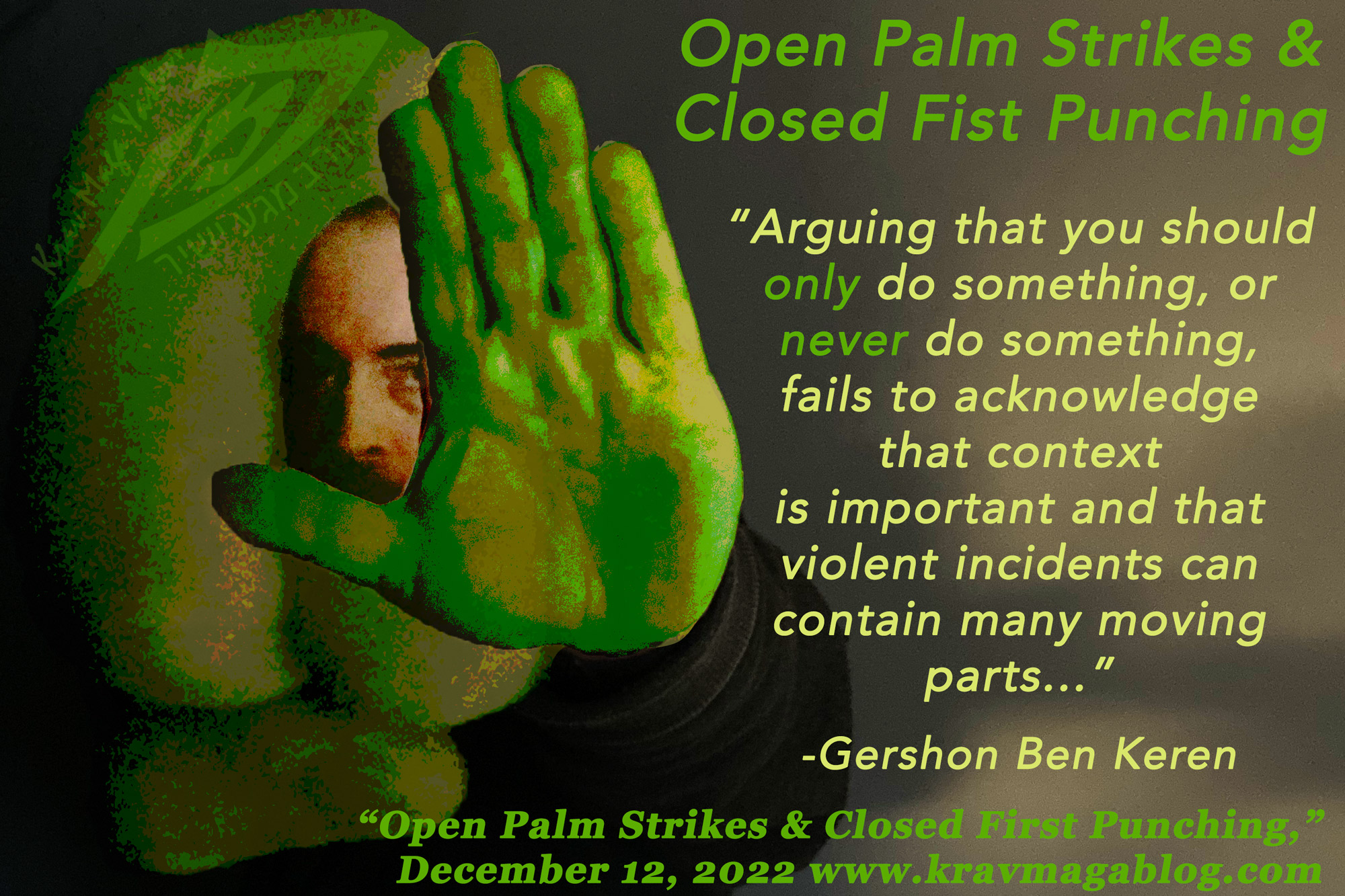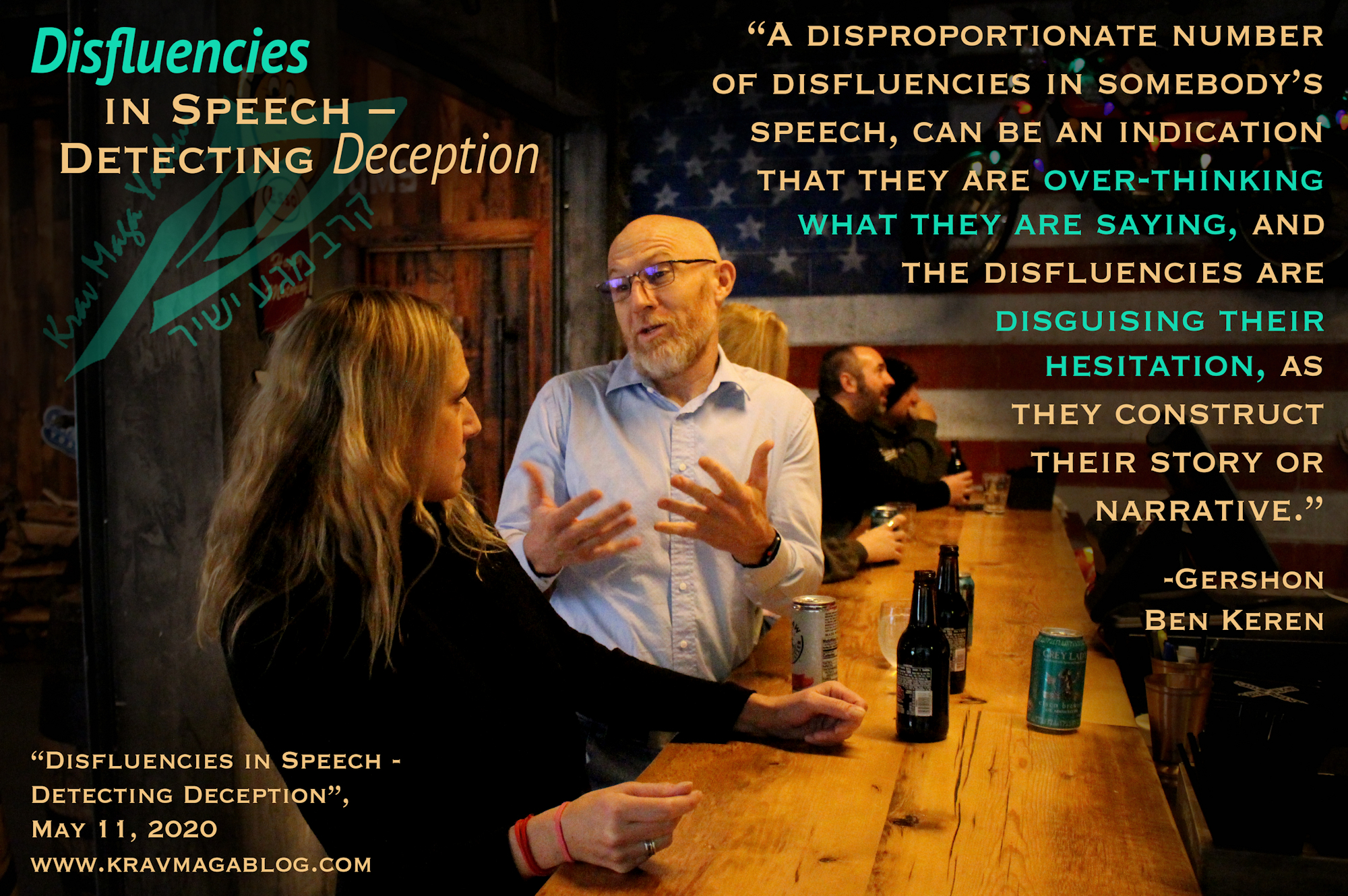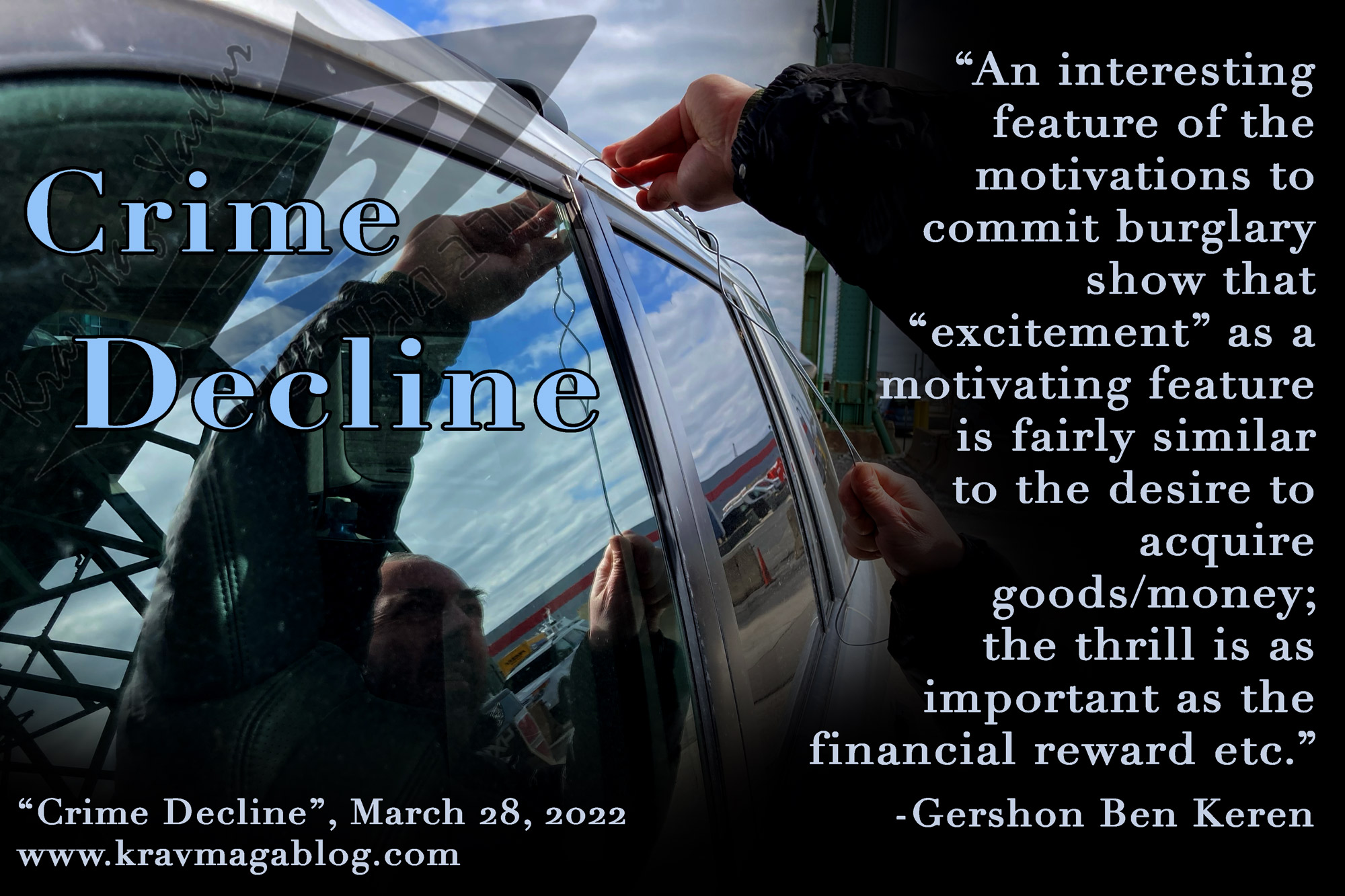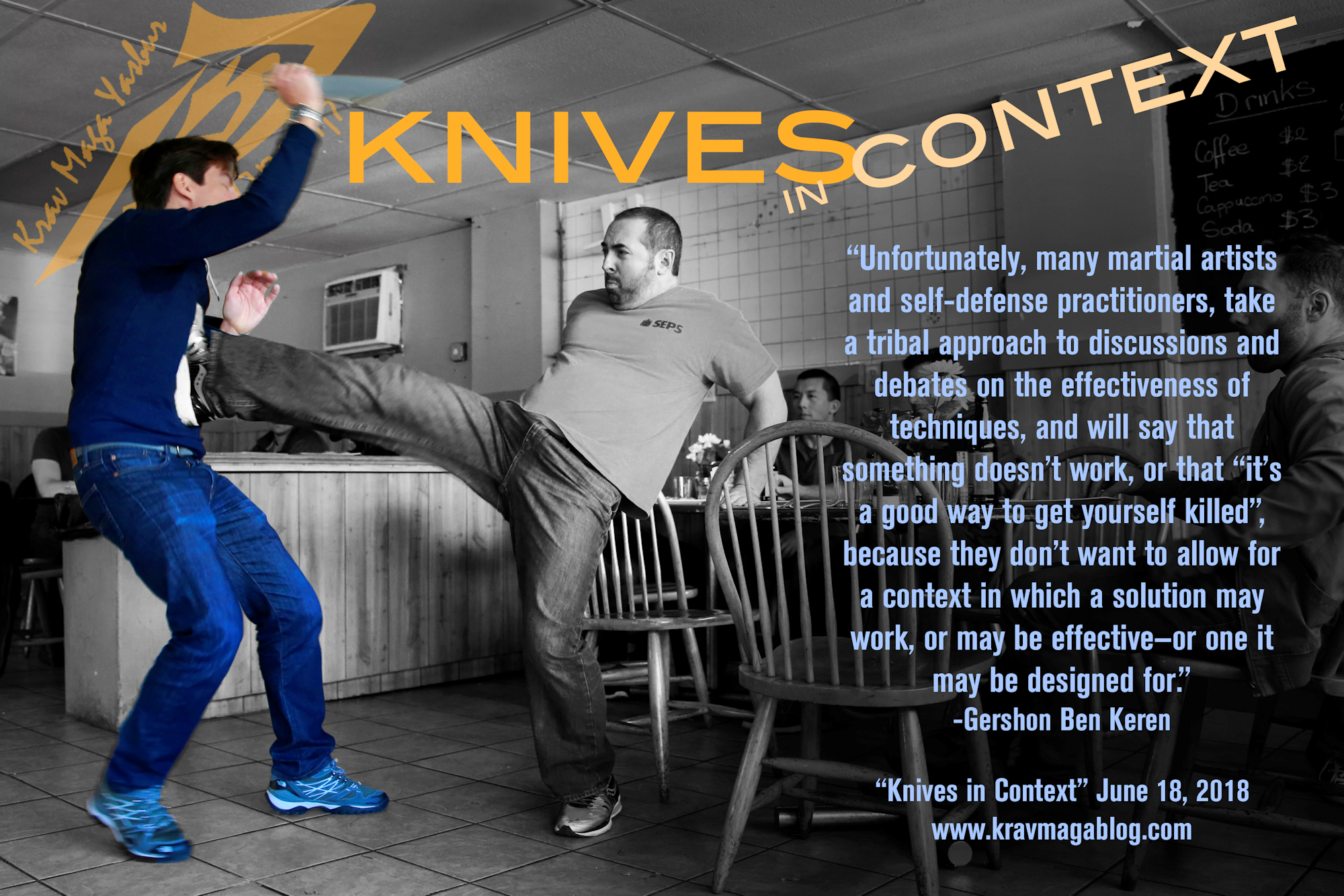Knives In Context, is an article written by Gershon Ben Keren, a 5th Degree Black Belt in Krav Maga, who teaches Krav Maga in Boston, MA. He has also authored three Amazon best-Selling Books on Krav Maga.
Everything works within its own context. Despite the claims of some systems/individuals that a particular solution or approach will always work, anyone who has a first-hand experience of violence will tell you that there are times when things that have worked well in a number of situations, aren’t necessarily going to work in every one. I see effective self-defense training, as teaching individuals how to recognize, create, and adapt to the situations they find themselves in, rather than blindly trying to fit square pegs in round holes, because all they have—and have been given—are square pegs. Violence is context-driven, and a solution that works well in one situation, may not be applicable to another – or it may involve trying to fit the wrong shape/sized peg, into a hole it wasn’t really designed for.
Unfortunately, many martial artists and self-defense practitioners, take a tribal approach to discussions and debates on the effectiveness of techniques, and will say that something doesn’t work, or that “it’s a good way to get yourself killed”, because they don’t want to allow for a context in which a solution may work, or may be effective—or one it may be designed for. One of the criticisms, that a lot of people make about Krav Maga, is around the use of the simultaneous block and punch/strike to deal with knife attacks; which in turn results in many Krav Maga proponents arguing—to defend what they see as an attack upon their system/approach—that this is a universal approach that should be applied in every type of knife attack. At the end of the day, context is the key to when something should be attempted and when it shouldn’t. There are good heuristics – rules of thumb – but these shouldn’t be dogmatically adhered to when the situation isn’t the one they’re designed for.
It would be simplistic to argue that a knife shank, is a knife shank, is a knife shank, etc. This is not the case. Watch some CCTV footage of a knife shank attack that targets a single individual, in an assassination-style assault e.g. an attacker has homed in on one individual, and is solely focused on them, etc. Then look at a terror attack, where an individual— or group—is moving around, looking to stab/kill as many people in a crowd as they can. The differing motive changes the nature of the attack, even though the knife is basically being deployed in the same way. When an assailant targets an individual, all they have to do is focus on that one person, if they are attacking a group, looking to kill as many people as possible (as in the London Bridge terror attack, June 3rd 2017), they need to move around from one person to another with their attention divided – the range and distance they are attacking at, especially if the group is scattering, is much greater, and people have an awareness that there is an assailant with a knife present. If you look at an attack that targets a single individual, the attack is usually an ambush, committed at extremely close range; certainly, within the assailant’s arms-reach. The non-weapon hand is also usually in play, with the attacker grabbing the clothing of their victim, and/or pushing/pulling them to either disrupt their balance, and/or prevent them from making distance and getting away. This is the reality of such attacks, and has to be acknowledged – at this range, which is essentially a grappling one, attempting to simultaneously block and punch, is extremely difficult (even if the punch or strike is only intended to disrupt rather than deliver power); especially if (as is often the case) the attacker chooses to make their assault, from an oblique angle, off to the side, rather than face-to-face.
A good drill to demonstrate this, is to have a partner with a training knife, stand about 30 centimeters i.e. a foot, off to the side of you at an angle. Don’t have them facing you but have them stand at an angle where they can keep their knife hidden—most assailants committed to stabbing you, won’t present the knife to you before the attack. Stand with your eyes closed, and only open them when your attacker grabs you and starts stabbing—have them also unbalance you as part of the attack (this is only going a small way to replicating the shock and surprise of a real-life attack). At this range, and with your balance upset, trying to divide your focus between blocking the short repetitive stabs of the knife and making an effective strike (even a disrupting one), is very, very difficult – and if your attacker keeps their face down, as is common with many attacks of this nature, finding the face as a target, under this type of pressure is extremely unlikely. In such instances, your focus has to be on controlling the weapon arm, and only once this is done, looking to disrupt your assailant, by striking, moving them, taking their balance, etc. Now change the scenario, to a terror attack, where an assailant has shown you the knife, and is screaming and running towards you; here you should have the time and the space, to deal with them combatively e.g. kick them away, block and strike, etc. It’s a different context. It’s not that one approach is right and another is wrong, but rather each is applicable in the situations where they work; round pegs for round holes, square pegs for square ones, etc.
Not all attacks are the same—even when they are, the attacker’s motive can change the nature of the attack. I remember watching an interview with Paul Ferris, a notorious Glasgow gangster, who was known as the “wee man”, on account of his short stature. Paul Ferris grew up using knives, and he told of the way he’d attack when he’d identified a target. It was to grab and hang on to them, at close range, and just keep pumping the knife into them, until they were unconscious—and sometimes afterwards. Having grown up in Glasgow, and having lived/worked in the UK, I know that this was not a unique approach; head/face down, with the knife arm moving like the needle of a sewing machine. An active killer—or group—with a knife, doesn’t have the luxury of focusing on one victim, they are looking to up their statistics, requiring as many dead and as many injured as possible—and they want to cause terror and mayhem, rather than “quietly” stabbing a single victim, over and over again. With space/distance and an attacker coming at you from the front, your combative solutions come into their own, as does your ability to use the environment to your advantage e.g. pick up a chair, get behind a table, etc. If we can lose the tribalism that characterizes much of the martial arts and self-defense world, and move beyond wanting to see ourselves as right, and everyone else as wrong; if we can see that context dictates what we do, and acknowledge that we may only be viewing a solution within the confines of our understanding, rather than in another context, we can prepare ourselves to deal with all incidents, not just the ones our experience or understanding restricts us to.
0 COMMENTS















